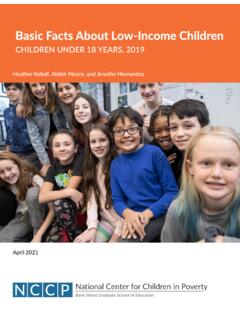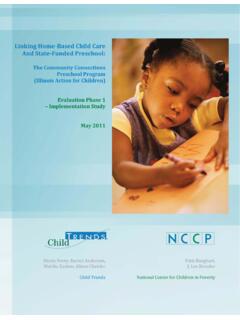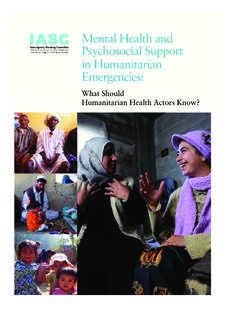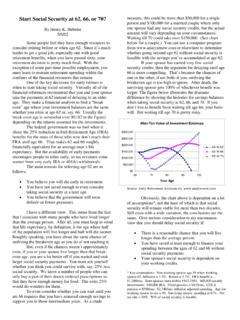Transcription of Social-emotional Development in Early Childhood
1 BriefSocial-emotional Development in Early ChildhoodWhat Every Policymaker should KnowJanice L. Cooper August 2009 Rachel MasiJessica Vick 2 Social-emotional Development in Early Childhood What Every policymaker should KnowJanice L. Cooper, Rachel Masi, Jessica VickCopyright 2009 by the National Center for Children in PovertyThe Early years of a child s life present a unique opportunity to foster healthy Development , and research has underscored the importance of the first five years of life both positive and negative experiences in shaping children s cognitive, behavioral, social , and emotional Development . This brief outlines the risks faced by young children with social , emo-tional, and behavioral problems, as well as barriers to eligi-bility, access to services, and service utilization.
2 The authors conclude by recommending policy improvements needed by young children and their families. AuThoRsJanice L. Cooper, PhD, is interim director at NCCP and assistant clinical professor, health Policy and Management at Columbia university Mailman school of Public health. Dr. Cooper directs unclaimed Children Revisited, a series of policy and impact analyses of mental health services for children, adolescents, and their Masi was a research assistant and Jessica Vick, PhD was a senior research analyst at NCCP until publication was supported by grants from the Irving harris and Mailman Foundations. special thanks to Morris Ardoin, Diana Barnes-Brown, Amy Palmisano, and Telly Valdellon of the NCCP Department of Communications and to research assistant shannon national Center for Children in poverty (nCCp) is the nation s leading public policy center dedicated to promoting the economic security, health, and well-being of america s low-income families and children.
3 Using research to inform policy and practice, nCCp seeks to advance family-oriented solutions and the strategic use of public resources at the state and national levels to ensure positive outcomes for the next generation. Founded in 1989 as a division of the mailman School of public health at Columbia University, nCCp is a nonpartisan, public interest research Center for Children in PovertySocial-emotional Development in Early Childhood 3 Social-emotional Development in Early ChildhoodWhat Every Policymaker should KnowJanice L. Cooper | Rachel Masi | Jessica Vick August 2009 The Early years of life present a unique opportunity to lay the foundation for healthy Development .
4 It is a time of great growth and of vulnerability. Research on Early Childhood has underscored the impact of the first five years of a child s life on his/her Social-emotional Development . Negative Early experiences can impair children s mental health and effect their cognitive, behavioral, Social-emotional The infant is embedded in relationships with others who provide the nutrition for both physical and psychological growth. 1the needs of young Children_____* Young children are defined as birth through age 5 for the purpose of this brief unless otherwise problems among young children* are common. Between and percent of children between birth and five years old experience Social-emotional problems that negatively impact their functioning.
5 Development and Approximately 9 percent of children who receive specialty mental health services in the United States are younger than 6 years Boys show a greater prevalence of behavior prob-lems than young children have more severe mental health health disorders in young childrenDisorderPrevalenceAnxiety Disorders1 to 11%Simple Phobias1 to 11%Oppositional Defiant Disorder1 to 26%Conduct Disorder1 to 5%Attention Deficit/Hyperactivity Disorder1 to 7% Prevalence rates of behavioral problems in pediatric primary care sample of preschool children by age and by gender (N=3,860)036912155 years4 years3 years2 : Lavigne, J.; Gibbons, R.; Christofel, K. K.; Arend, R.; Rosenbaum, D.; Binns, H.
6 Et al. 1996. Prevalence Rates and Correlates of Psychiatric Disorders among Preschool Children. Journal of the American Academy of Child and Adolescent Psychiatry 35: and Environmental risk FactorsSpecific family and environmental factors can make a child more vulnerable to social , emotional and behavioral characteristics and family income can be risk factors that impact young children s Social-emotional health and Development . Young children in low-income neighborhoods are more likely to experience behavioral prob-lems than children living in moderate or affluent Young children from households with lower levels of family income are more likely to experience behavioral problems that negatively impact their suggests that up to 50 percent of the impact of income on children s Development can be mediated by interventions that target and caregivers play an important role in supporting children s healthy Development .
7 Research shows that family risk factors, particularly maternal risk factors such as substance use, mental health conditions and domestic violence exposure, can impact parents ability to support children s Development , and may contribute to behavioral problems among young children as Early as age Young children with these family risks factors have been found to be two to three times more likely than children without these family risk factors to experience problems with aggression (19% vs. 7%) anxiety and depression (27% vs. 9%) and hyperactivity (19% vs. 7%).11 Attachment is an important marker for Social-emotional Development . Poor attachment, especially maternal attachment, can negatively impact chil-dren s Social-emotional health, and Development .
8 Almost two-fifths of two-year-olds in Early care and learning settings had insecure attachment relationships with their mothers. In particular, research shows that African-American and Latino young children experience lower levels of secure attachment than Asian-American and White Children of parents with mental illness are at a greater risk for psychosocial problems. More than two-thirds of adults with mental illness are Between 30 and 50 percent of children with parents who are mentally ill have a psychiatric diagnosis, compared to 20 percent of children in the general Children of parents with a mental illness may also show higher rates of difficulties with regulating their emotions, relationship problems and devel-opmental the mental health problems of non-relative caregivers affect the quality of children s Early expe-riences in their care.
9 Adults who work in childcare centers have higher rates of depression than found in the general Caregivers who report depressive symp-toms are more likely to be detached, insensitive and interact less with children in their care than non-familial caregivers who are not National Center for Children in PovertySocial-emotional Development in Early Childhood 5the role of Foster Care and Child WelfareYoung children in child welfare settings have greater need and are less likely to receive percent of children in foster care are younger than age Children, ages two- to five-years-old, in child welfare (including those in foster care) have a greater proportion of social , emotional, and behavioral problems than children in the general population, and within child welfare, compared to older children, young children are less likely to receive mental health One-third of children ages 2 to 5 in child welfare need mental health services and related race and Ethnicity matterYoung children of color are more likely to experience key risk children of color are more likely to experi-ence factors that put them at risk for poor social , emotional, and behavioral Development .
10 These chil-dren are also over-represented in child welfare, and make up the largest proportion of children expelled from preschool and in specialty mental health care. Among young children victimized in 2007, 49 percent were children of color (African-American 21%, Latino 22%, Asian-Pacific Islanders 1%, Multi-racial 3% and American Indian/Alaska Natives 1%).21 African-Americans are overrepresented in the population of maltreated children age 0 to 5 (21% vs. 14% in the general population).22 Forty percent of the preschoolers in specialty mental health services are children of color (African-American and Latino ).23 In Early care and learning settings, African-American young children are between three and five times more likely to be expelled than their African-American children are times more likely to have a parent incarcerated than white children (overall nearly 25 percent of children under age 5 had an incarcerated parent).













